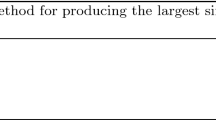Abstract
Despite the large success of deep neural networks (DNN) in recent years, most neural networks still lack mathematical guarantees in terms of stability. For instance, DNNs are vulnerable to small or even imperceptible input perturbations, so called adversarial examples, that can cause false predictions. This instability can have severe consequences in applications which influence the health and safety of humans, e.g., biomedical imaging or autonomous driving. While bounding the Lipschitz constant of a neural network improves stability, most methods rely on restricting the Lipschitz constants of each layer which gives a poor bound for the actual Lipschitz constant.
In this paper we investigate a variational regularization method named CLIP for controlling the Lipschitz constant of a neural network, which can easily be integrated into the training procedure. We mathematically analyze the proposed model, in particular discussing the impact of the chosen regularization parameter on the output of the network. Finally, we numerically evaluate our method on both a nonlinear regression problem and the MNIST and Fashion-MNIST classification databases, and compare our results with a weight regularization approach.
This work was supported by the European Union’s Horizon 2020 research and innovation programme under the Marie Skłodowska-Curie grant agreement No. 777826 (NoMADS) and by the German Ministry of Science and Technology (BMBF) under grant agreement No. 05M2020 (DELETO).
Access this chapter
Tax calculation will be finalised at checkout
Purchases are for personal use only
Similar content being viewed by others
Notes
References
Anil, C., Lucas, J., Grosse, R.B.: Sorting out Lipschitz function approximation. In: ICML, vol. 97, pp. 291–301. PMLR (2019)
Anzengruber, S.W., Ramlau, R.: Morozov’s discrepancy principle for Tikhonov-type functionals with nonlinear operators. Inverse Probl. 26(2), 025001 (2009)
Aziznejad, S., Gupta, H., Campos, J., Unser, M.: Deep neural networks with trainable activations and controlled Lipschitz constant. IEEE Trans. Signal Process. 68, 4688–4699 (2020)
Bungert, L., Burger, M.: Solution paths of variational regularization methods for inverse problems. Inverse Probl. 35(10), 105012 (2019)
Bungert, L., Burger, M., Korolev, Y., Schönlieb, C.B.: Variational regularisation for inverse problems with imperfect forward operators and general noise models. Inverse Probl. 36(12), 125014 (2020)
Burger, M., Osher, S.: A guide to the TV zoo. In: Level Set and PDE Based Reconstruction Methods in Imaging, vol. 2090, pp. 1–70. Springer, Cham (2013). https://doi.org/10.1007/978-3-319-01712-9_1
Combettes, P.L., Pesquet, J.C.: Lipschitz certificates for layered network structures driven by averaged activation operators. SIAM J. Math. Data Sci. 2(2), 529–557 (2020)
Fazlyab, M., Robey, A., Hassani, H., Morari, M., Pappas, G.: Efficient and accurate estimation of Lipschitz constants for deep neural networks. In: NeurIPS (2019)
Goodfellow, I.J., Shlens, J., Szegedy, C.: Explaining and harnessing adversarial examples. In: ICLR (2015)
Gouk, H., Frank, E., Pfahringer, B., Cree, M.J.: Regularisation of neural networks by enforcing Lipschitz continuity. Mach. Learn. 110, 1–24 (2020). https://doi.org/10.1007/s10994-020-05929-w
Huster, T., Chiang, C.-Y.J., Chadha, R.: Limitations of the Lipschitz constant as a defense against adversarial examples. In: Alzate, C., et al. (eds.) ECML PKDD 2018. LNCS (LNAI), vol. 11329, pp. 16–29. Springer, Cham (2019). https://doi.org/10.1007/978-3-030-13453-2_2
Krishnan, V., Makdah, A.A.A., Pasqualetti, F.: Lipschitz bounds and provably robust training by Laplacian smoothing. arXiv preprint arXiv:2006.03712 (2020)
Krizhevsky, A.: Learning multiple layers of features from tiny images. Technical report (2009)
LeCun, Y., Bottou, L., Bengio, Y., Haffner, P., et al.: Gradient-based learning applied to document recognition. Proc. IEEE 86(11), 2278–2324 (1998)
Liang, Y., Huang, D.: Large norms of CNN layers do not hurt adversarial robustness. arXiv preprint arXiv:2009.08435 (2020)
Madry, A., Makelov, A., Schmidt, L., Tsipras, D., Vladu, A.: Towards deep learning models resistant to adversarial attacks. In: ICLR (2018)
Oberman, A.M., Calder, J.: Lipschitz regularized deep neural networks converge and generalize. arXiv preprint arXiv:1808.09540 (2018)
van den Oord, A., et al.: WaveNet: a generative model for raw audio. In: The 9th ISCA Speech Synthesis Workshop, p. 125 (2016)
Osher, S., Burger, M., Goldfarb, D., Xu, J., Yin, W.: An iterative regularization method for total variation-based image restoration. Multiscale Model Sim. 4(2), 460–489 (2005)
Roth, K., Kilcher, Y., Hofmann, T.: Adversarial training is a form of data-dependent operator norm regularization. In: NeurIPS (2019)
Ruder, S.: An overview of gradient descent optimization algorithms. arXiv preprint arXiv:1609.04747 (2016)
Scaman, K., Virmaux, A.: Lipschitz regularity of deep neural networks: analysis and efficient estimation. In: NeurIPS (2018)
Schwinn, L., Raab, R., Eskofier, B.: Towards rapid and robust adversarial training with one-step attacks. arXiv preprint arXiv:2002.10097 (2020)
Shafahi, A., et al.: Adversarial training for free! In: NeurIPS, pp. 3353–3364 (2019)
Shalev-Shwartz, S., Ben-David, S.: Understanding Machine Learning: From Theory to Algorithms. Cambridge University Press, New York (2014)
Szegedy, C., et al.: Intriguing properties of neural networks. In: International Conference on Learning Representations (2014)
Terjék, D.: Adversarial Lipschitz regularization. arXiv preprint arXiv:1907.05681 (2019)
Xiao, H., Rasul, K., Vollgraf, R.: Fashion-MNIST: a novel image dataset for benchmarking machine learning algorithms (2017)
Zou, D., Balan, R., Singh, M.: On Lipschitz bounds of general convolutional neural networks. IEEE Trans. Inf. Theory 66(3), 1738–1759 (2019)
Author information
Authors and Affiliations
Corresponding author
Editor information
Editors and Affiliations
Rights and permissions
Copyright information
© 2021 Springer Nature Switzerland AG
About this paper
Cite this paper
Bungert, L., Raab, R., Roith, T., Schwinn, L., Tenbrinck, D. (2021). CLIP: Cheap Lipschitz Training of Neural Networks. In: Elmoataz, A., Fadili, J., Quéau, Y., Rabin, J., Simon, L. (eds) Scale Space and Variational Methods in Computer Vision. SSVM 2021. Lecture Notes in Computer Science(), vol 12679. Springer, Cham. https://doi.org/10.1007/978-3-030-75549-2_25
Download citation
DOI: https://doi.org/10.1007/978-3-030-75549-2_25
Published:
Publisher Name: Springer, Cham
Print ISBN: 978-3-030-75548-5
Online ISBN: 978-3-030-75549-2
eBook Packages: Computer ScienceComputer Science (R0)




